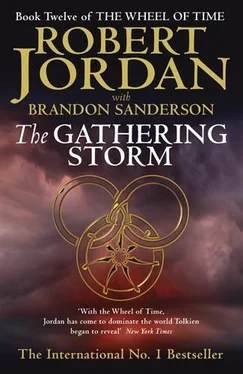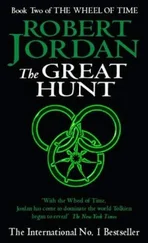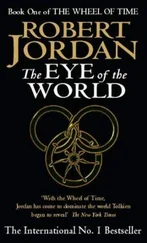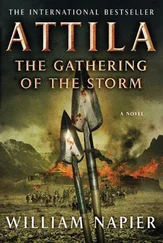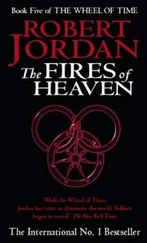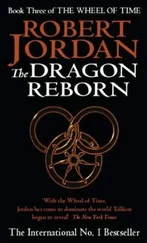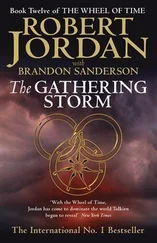If so, she somehow knew how to defeat the Oath Rod.
A soft knock came at her door. It cracked a moment later. “Mother?” Silviana asked.
Egwene looked up, raising her eyebrows.
“I thought you might want to see this,” Silviana said, entering, her hair back in its tidy black bun, the red Keeper’s stole around her shoulders.
“What is it?”
“You should come and see.”
Curious, Egwene rose. There was no tension to Silviana’s voice, so it couldn’t be anything too dire. The two of them left the study behind, walking around the outside of the building to the Hall of the Tower. When they reached it, Egwene raised an eyebrow. Silviana gestured for her to enter.
The Hall wasn’t in session, and the chairs sat empty. A scattering of mason’s tools lay on white sheets in the corner, and a group of workers in thick brown overalls and white shirts—sleeves rolled up—were collected in front of the gap in the wall that the Seanchan had left. Egwene had ordered a rose window fitted into the opening instead of having it sealed up completely, a remembrance for the time the White Tower had been attacked. A warning to prevent its happening again. Before the window could be installed, however, stonemasons were busy shoring up the sides and creating the fitting.
Egwene and Silviana glided into the room, walking down the short ramp to the floor, which had again been properly painted with the colors of all seven Ajahs. The stonemasons saw them, then backed away respectfully, one man pulling off his cap and clutching it to his chest. Reaching the edge of the room, just before the opening, Egwene finally saw what Silviana had brought her to see.
After all this time, the clouds had finally broken. They had pulled back in a ring around Dragonmount. The sun shone down, radiant, lighting the distant, snowcapped crag. The broken maw and uppermost peak of the blasted mountainside were bathed in light. It was the first time Egwene could remember seeing direct sunlight in weeks. Perhaps longer.
“Some novices noticed it first, Mother,” Silviana said, stepping up beside her. “And news spread quickly. Who would have thought that a little ring of sunlight would cause such a stir? It’s such a simple thing, really. Nothing we haven’t seen before. But. . . .”
There was something beautiful about it. The light streaming down in a column, strong and pure. Distant, yet striking. It was like something forgotten, but somehow still familiar, shining forth from a distant memory to bring warmth again.
“What does it mean?” Silviana asked.
“I don’t know,” Egwene said. “But I welcome the sight of it.” She hesitated. “That opening in the clouds is too even to be natural. Mark this day on the calendars, Silviana. Something has happened. Perhaps, eventually, we shall know the truth of it.”
“Yes, Mother,” Silviana said, looking out through the gap again.
Egwene stood with her, rather than returning to her study immediately. It felt relaxing to stare out at that distant light, so welcoming and noble. “Storms will soon come,” it seemed to say. “But for now, I am here.”
I am here.
The Gathering Storm
At the end of time,
when the many become one,
the last storm shall gather its angry winds
to destroy a land already dying.
And at its center, the blind man shall stand
upon his own grave.
There he shall see again,
and weep for what has been wrought.
-from The Prophecies of the Dragon, Essanik Cycle. Malhavish’s Official Translation, Imperial Record House of Seandar, Fourth Circle of Elevation.
The End of the Twelfth Book of
The Wheel of Time
Note on Dates in This Glossary.A The Toman Calendar (devised by Toma dur Ahmid) was adopted approximately two centuries after the death of the last male Aes Sedai, recording years After the Breaking of the World (AB). So many records were destroyed in the Trolloc Wars that at their end there was argument about the exact year under the old system. A new calendar, proposed by Tiam of Gazar, celebrated freedom from the Trolloc threat and recorded each year as a Free Year (FY). The Gazaran Calendar gained wide acceptance within twenty years after the Wars’ end. Artur Hawkwing attempted to establish a new calendar based on the founding of his empire (FF, From the Founding), but only historians now refer to it. After the death and destruction of the War of the Hundred Years, a third calendar was devised by Uren din Jubai Soaring Gull, a scholar of the Sea Folk, and promulgated by the Panarch Farede of Tarabon. The Farede Calendar, dating from the arbitrarily decided end of the War of the Hundred Years and recording years of the New Era (NE), is currently in use.
Aelfinn:A race of beings, largely human in appearance but with snake-like characteristics, who will give true answers to three questions. Whatever the question, their answers are always correct, if frequently given in forms that are not clear, but questions concerning the Shadow can be extremely dangerous. Their true location is unknown, but they can be visited by passing through a ter’angreal, once a possession of Mayene but in recent years held in the Stone of Tear. There are reports that they can also be reached by entering the Tower of Ghenjei. They speak the Old Tongue, mention treaties and agreements and ask if those entering carry iron, instruments of music or devices that can make fire. See also Eelfinn.
Arad Doman:A nation on the Aryth Ocean, currently racked by civil war and by wars against those who have declared for the Dragon Reborn. Its capital is Bandar Eban, where many of its people have come for refuge. Food is scarce. In Arad Doman, those who are descended from the nobility at the time of the founding of the nation, as opposed to those raised later, are known as the bloodborn. The ruler (king or queen) is elected by a council of the heads of merchant guilds (the Council of Merchants), who are almost always women. He or she must be from the noble class, not the merchant, and is elected for life. Legally the king or queen has absolute authority, except that he or she can be deposed by a three-quarter vote of the Council. The current ruler is King Alsalam Saeed Almadar, Lord of Almadar, High Seat of House Almadar. His present whereabouts are much shrouded in mystery.
Area, units of:(1) Land: 1 ribbon = 20 paces X 10 paces (200 square paces); 1 cord = 20 paces X 50 paces (1000 square paces); 1 hide = 100 paces X 100 paces (10,000 square paces); 1 rope = 100 paces X 1000 paces (100,000 square paces); 1 march = 1000 paces X 1000 paces ( l A square mile). (2) Cloth: 1 pace = 1 pace plus 1 hand X 1 pace plus 1 hand.
Asha’man:(1) Inthe Old Tongue, “Guardian” or “Guardians,” but always a guardian of justice and truth. (2) The name given, both collectively and as a rank, to the men who have come to the Black Tower, near Caemlyn in Andor, in order to learn to channel. Their training largely concentrates on the ways in which the One Power can be used as a weapon, and in another departure from the usages of the White Tower, once they learn to seize saidin, the male half of the Power, they are required to perform all chores and labors with the Power. When newly enrolled, a man is termed a Soldier; he wears a plain black coat with a high collar, in the Andoran fashion. Being raised to Dedicated brings the right to wear a silver pin, called the Sword, on the collar of his coat. Promotion to Asha’man brings the right to wear a Dragon pin, in gold and red enamel, on the collar opposite the Sword. Although many women, including wives, flee when they learn that their men actually can channel, a fair number of men at the Black Tower are married, and they use a version of the Warder bond to create a link with their wives. This same bond, altered to compel obedience, has recently been used to bond captured Aes Sedai as well. Some Asha’man have been bonded by Aes Sedai, although the traditional Warder bond is used. The Asha’man are led by Mazrim Taim, who has styled himself the M’Hael, Old Tongue for “leader.”
Читать дальше
